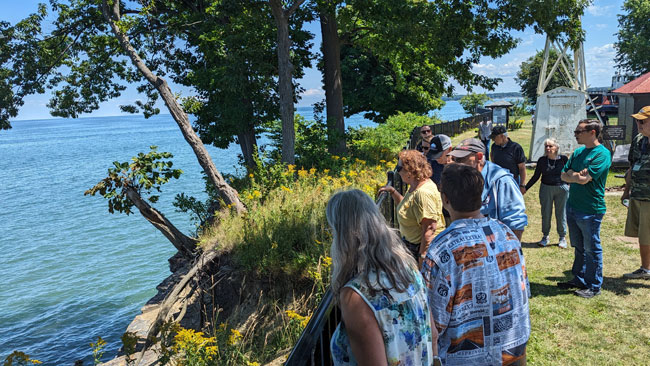
During a New York Sea Grant workshop on nature-based features in 2024, local residents observe cliff erosion at a historical lighthouse in Dunkirk, NY. Credit: Roy Widrig/NYSG
Contact:
Roy Widrig, NYSG Great Lakes Coastal Processes and Hazards Specialist, E: rlw294@cornell.edu, P: (315) 234-1916
NYSG expertise with coastal processes and hazards is assisting residents, groups, and communities with responding to shoreline erosion impact
Oswego, NY, May 27, 2025 - The dynamic forces acting on the shoreline of the Great Lakes can result in significant coastal erosion and flooding, directly impacting New York State residents’ ability to live, work, and recreate along NY’s coasts. New York’s shorelines - the vast majority of which are privately owned - are subject to periodic erosion and flooding. Very few educational opportunities exist for shoreline residents related to living on these dynamic shorelines.
In 2024, through direct contacts and the New York Sea Grant (NYSG) Virtual Site Visit reporting tool (www.nyseagrant.org/virtualsitevisit), NYSG consulted on 42 separate shoreline stretches, providing advice on shoreline management options, other science-based
information, and shoreline project permitting.
In addition to site visits, NYSG offered workshops on nature-based shoreline erosion management (Dunkirk, July) and on seiche events (Angola, October). The workshops resulted in 64 direct contacts with shoreline residents learning about weather and shoreline dynamics, shoreline flooding and erosion management prevention strategies, and permitting. Shoreline site visits resulted in surveys of, and shoreline management recommendations for, approximately 7,000 feet of New York’s Great Lakes shoreline. “Shoreline Resident Folders” were provided to all workshop attendees and residents who received in-person site visits.
NYSG consults with shoreline residents, groups, and communities, and hosts workshops in the eight counties across the Lake Erie and Lake Ontario shorelines to inform and enhance planning, preparation, and response to shoreline erosion events and impacts.
Project Partners/Funders:
• City of Dunkirk
• Lake Erie Watershed Protection Alliance
• National Weather Service
• New York State Department of State
• Town of Evans
• Funding: New York State Department of Environmental Conservation
More Info: New York Sea Grant
Established in 1966, the National Oceanic and Atmospheric Administration (NOAA)’s National Sea Grant College Program promotes the informed stewardship of coastal resources in 34 joint federal/state university-based programs in every U.S. coastal state (marine and Great Lakes) and Puerto Rico. The Sea Grant model has also inspired similar projects in the Pacific region, Korea and Indonesia.
Since 1971, New York Sea Grant (NYSG) has represented a statewide network of integrated research, education and extension services promoting coastal community economic vitality, environmental sustainability and citizen awareness and understanding about the State’s marine and Great Lakes resources.
NYSG historically leverages on average a 3 to 6-fold return on each invested federal dollar, annually. We benefit from this, as these resources are invested in Sea Grant staff and their work in communities right here in New York.
Through NYSG’s efforts, the combined talents of university scientists and extension specialists help develop and transfer science-based information to many coastal user groups—businesses and industries, federal, state and local government decision-makers and agency managers, educators, the media and the interested public.
New York Sea Grant, one of the largest of the state Sea Grant programs, is a cooperative program of the State University of New York (SUNY) and Cornell University. The program maintains Great Lakes offices at Cornell University, SUNY Buffalo, Rochester Institute of Technology, SUNY Oswego, the Wayne County Cooperative Extension office in Newark, and in Watertown. In the State's marine waters, NYSG has offices at Stony Brook University and with Cornell Cooperative Extension of Nassau County on Long Island, in Queens, at Brooklyn College, with Cornell Cooperative Extension in NYC, in Bronx, with Cornell Cooperative Extension of Ulster County in Kingston, and with Cornell Cooperative Extension of Westchester County in Elmsford.
For updates on Sea Grant activities: www.nyseagrant.org, follow us on social media (Facebook, Twitter/X, Instagram, Bluesky, LinkedIn, and YouTube). NYSG offers a free e-list sign up via www.nyseagrant.org/nycoastlines for its flagship publication, NY Coastlines/Currents, which it publishes 2-3 times a year.